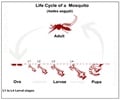Scientists have completed the first draft of the genome sequence of Aedes aegypti mosquito, thereby moving one step further towards the development of new strategies to prevent and control Fever
Scientists have completed the first draft of the genome sequence of Aedes aegypti mosquito, thereby moving one step further towards the development of new strategies to prevent and control yellow fever and dengue fever.
The genome sequencing was done by researchers from 24 universities and other institutions, led by Vishvanath Nene at The Institute for Genomic Research (TIGR) and David Severson at the University of Notre Dame.Zhijian Tu, a co-author and member of the Vector-Borne Infectious Disease Research Group at Virginia Tech, helped annotate transposable elements (TEs), genetic material that move around the mosquito’s genome and have a significant impact on its structure and size.
Another Virginia Tech researcher Jinsong Zhu, Assistant Professor of Biochemistry, has so far helped validate 80 per cent of the15,419 predicted protein coding genes in Ae. aegypti.
"An important part of this project is gene annotation which predicts numbers and locations of mosquito genes in the genome. In parallel to sequencing DNA in chromosomes, scientists have also sequenced large amounts of messenger RNAs collected from different mosquito tissues at distinct developmental stages. Matching a messenger RNA to a predicted gene will validate authenticity of this gene," he explains.
Zhijian Tu’s team has uncovered and described more than 1,000 TEs that occupy about 50 per cent of the entire Ae. Aegypti genome.
"Although the majority of protein coding TE copies in Ae. aegypti appear to be degenerate, a significant number of elements have potentially active TE copies, indicating that they may be developed as tools for genetic studies of mosquitoes," said the researcher.
Advertisement
The researchers believe that TEs may be developed as genetic tools to study the interaction between mosquitoes and pathogens, and thus may lead to controls of transmission of disease.
Advertisement
"By introducing TEs in a more or less random way to see what happens to the laboratory mosquitoes, the TEs become a tool to study the genetic mechanism of mosquito-virus interaction, to help us understand mosquito biology and reveal new ways to interfere with disease transmission," Tu said.
The Ae. aegypti genome sequence has been described in the article ‘Genome Sequence of Aedes aegypti, A Major Arbovirus Vector’, published in Science Express. It is expected to stimulate efforts to elucidate interactions at the molecular level between mosquitoes and the pathogens they transmit to humans.
Source-ANI
LIN/B










